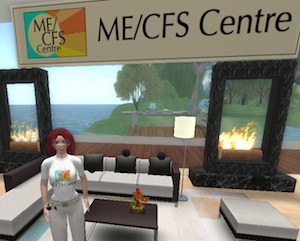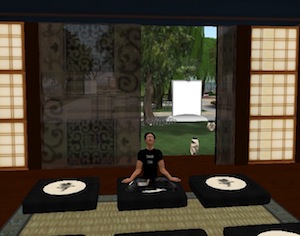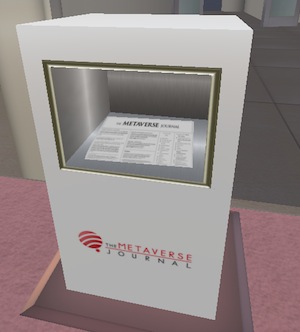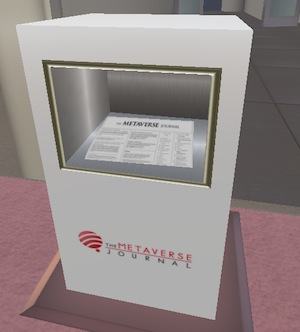 This story appeared originally on Metaverse Health.
This story appeared originally on Metaverse Health.
In recent weeks, thanks to a health professional colleague, I became aware of a research project underway at Murdoch University, looking at the use of virtual worlds as a support mechanism for people with Myalgic Encephalomyelitis/Chronic Fatigue Syndrome (ME/CFS). It’s an ARC funded, three-year project titled Isolation, illness and the Internet: Exploring the possibility of a second life for sufferers of ME.
Chief Investigator for the research is Kirsty Best, a lecturer in Communication and Media Studies. She kindly spent some time explaining the research project and providing some insight on the wider issues faced by those with ME/CFS. There is also a further viewpoint after the Q&A section from Alex, an Australian living with ME/CFS who has been taking part in the project.
DH: To start off, can I get you to tell me a little about yourself, your specific role at Murdoch and with this project?
KB: I’m a Senior Lecturer with the School of Media, Communication and Culture. I received an ARC Discovery grant last year – the project and the centre are the result of that grant but I am planning to keep it going after funding runs out.
DH: So the part we’re standing in now contains resources on ME/CFS?
KB: I have created some user-friendly resources about ME/CFS. They’re aimed both at people with ME, who end up having to do a LOT of research on their own due to ignorance of the illness, and the general public. We also have a calendar of what’s going on. Then over here I have some major ME/CFS websites that I have found the most useful and user-friendly, with various theories of the cause, various treatment protocols and also support groups.
DH: With the cause theories, how have you assessed their validity?
KB: That’s not my area of expertise, and it’s not about that. This is about giving people with a very misunderstood illness the resources they need to find out more, get support, and be heard. I’m not a scientist. Some of our members are very interested in the biochemistry, etc and in our mailing list and groups the discussions often end up talking about some of these things.
DH: Absolutely – but what I’m getting at is how do you determine that the information is clinically sound? Let’s say an illegitimate site popped up making incorrect claims that could cause harm – how do you screen that?
KB: I don’t screen that. There are a lot of competing theories out there. I am just providing links to the sites that provide the best summaries of what has been said so far. To be honest, VERY little scientific research is even conducted about ME/CFS
DH: Ok, that makes sense. I suppose what I’m getting at is some of the value add for virtual worlds and health can be to provide guidance on the evidence-base or to debunk incorrect information.
KB: That is not what my work is about. I am not looking into causes and effects. I have no training in that. I am looking to provide people with ways to overcome their social isolation using virtual media. This area is a very small part of what the centre is about.
DH: Can you tell me a little about the research you are conducting here?
KB: It’s ongoing. I’m interviewing people with ME/CFS from Canada and from Australia about how and whether computers and the Internet help to ease some of the isolation they experience due to their illness, getting them set up with an avatar, getting them oriented and then seeing if SL is a useful way of supplementing some of their other Internet-based activities or whether it is too hard.
DH: Can you give any details on the methodology you’re using in the research e.g. specific qualitative or quantitative methods?
KB: I have conducted the first round of interviews, we will be having focus groups then more interviews. It’s all qualitiative.
 DH: So how large is the first group?
DH: So how large is the first group?
KB: Thee’s roughly forty people.
DH: Can you describe the experience of the interviews and activities to date?
KB: Some had to drop out because of the requirements of SL: they didn’t have broadband for instance, or a fast enough computer. Real accessibility issues. But to be honest, the most important accessibility issues for people with ME are not just about hardware or bandwidth. It’s an illness that affects all systems in the body, including cognitive, and so orientation and navigation become very problematic. I do a LOT of troubleshooting. But there are benefits people are experiencing as well. It’s a mixed bag. A series of tradeoffs. People really like the social interaction, but getting their heads around the technology is hard.
However I have to say that Second Life DOES give an experience that is unique, and that people like. At the last meeting, one of our members who hadn’t been able to make it in a while said that when she saw us standing there, she felt like running up and hugging us, if she knew how to do it! She said how it really made her feel like she knew these people, and since she is pretty much housebound, having the visuals and the voice, and the virtual environment really made a difference. I’m not sure it’s worth the tradeoffs for some people, but for some it definiitely is – it depends on people’s levels of dysfunction in relation to spatial orientation to a large extent.
DH: What made you choose CFS as the research topic? Was it a personal interest?
KB: I’m very passionate about it, yes. These people have the worst of all worlds. They have a devastating illness in terms of quality of life, they have very little support from the medical community, and have to do pretty much all the research themselves–which of course they don’t have the energy for. And they have very little support from their friends and family. In fact this comes up quite a lot, and people are CONSTANTLY saying how their friends and family don’t believe them. or don’t support them, or what have you. And so this place is somewhere they can actually be understood.
DH: Was there a specific event that led you to understand how hard it is for CFS sufferers?
KB: I have a close family member who has had ME/CFS for – it must be 12 or more years now. It prompted me to do a lot of research about the condition. Let’s just say that whenever I try to explain the condition, or this project to anyone, I experience it for myself. I get very defensive. People with cancer or MS don’t feel they are having to constantly justify their illness. It’s very draining. And I”m healthy! It’s FAR worse for them.
DH: In regards to lack of support from the medical community, why do you think that is?
KB: I have been involved with volunteering for an organization in Canada that was actually LAUGHED at by a doctor when they approached him to see if he would speak at an ME/CFS Awareness Day. I think it’s changing slowly though. But very slowly. The Canadian Consensus Definition is extremely important to this – all the other clinical definitions have been sorely lacking.
DH: So for you, what would be measures of success for you, for both the research and the support here more broadly?
KB: Well success for the research would be finding out in what ways virtual environments such as SL can help this marginalized community, despite their cognitive and spatial difficulties. Hopefully we will find out specifically what is working and what isn’t. We already take our members to Virtual Ability island, who have been very helpful. But there are still a lot of ways that the evironment is very challenging to people with ME/CFS, as I have said.
I’m not sure these can be overcome completely. I think part of it is intrinsic to technology itself. There will always be these black holes where the technology fails us, no matter how advanced it gets, because bugs and usability issues are eternal. And for someone with ME/CFS, these are magnified 5000 percent. So I guess success is simply finding ways of amelioriating these black holes, if we know what to look for. I don’t think this environment will ever be for everyone with ME/CFS, but for those it reaches, its impact can be profound. I would say that is success.
DH: You mentioned that ME/CFS sufferers can experience cynicism from some health professionals – if this research demonstrates outcomes as far as social support, could this make those cynics sit up and take notice as whether they ‘believe’ in ME or not, the results will speak for themselves and need to be acknowledged?
KB: It doesn’t prove anything about the nature or reality of ME however. Unfortunate but true. I think you only have to speak to these people and be around them for a while to understand. See them totally struggle with things we find complely simple and no big deal. So I think the only thing that will potentially change someone’s mind is if they were to come here and join us for a few weeks! However, I think it’s really a culture change that needs to go on in both broader society and in the health community.
As there are more and more individuals coming forward and publicising their experiences (in books, online, in other media), as there are more and more projects and support groups and spaces such as this one that are springing up, then the community and the illness can’t help but be noticed. At this point, the culture of cynicism will hopefully slip and be replaced. So I guess I see this is a tiny brick in the wall. I do want to use it as a way to generate awareness in the broader SL community at least. I would like to hold events here and so on. How many health professionals there are that use SL I don’t know!
DH: There are quite a few 😉 Could you forsee collaborative research in the future, with say allied health professionals, on the use of virtual worlds as a support mechanism?
KB: Oh yes, that would be great, but that’s not about changing anyone’s mind. Those health professionals would already be open to it. The people who don’t believe, you can’t really budge them. I hear this over and over again from our members. I believe it. However, as I said, it is changing slowly, so there are some people who would be more open in the first place. They would be the kind we could collaborate with. The “early adopters” so to speak.
===
Alex’s perspective:
Firstly, due to my illness I frequently do not enjoy being on Second Life. This isn’t about fun, it’s about need. I am too sick to function in the real world, but Second Life gives me just that – a chance to interact with people and alleviate the worst affects of severe isolation, in combination with a sense of being in the world, albeit virtual. (I play open world RPGs for much the same sense of being in the world). SL still makes demands on my health, just not as much as real life. One of the big issues is preventing desocialisation – we can become so isolated that we no longer relate to other people. Second Life allows for avatar-to-avatar talks, which while it isn’t as good as real life it does have its benefits.
For the first time I have met another person with long term ME/CFS who has similar health to me. Most people involved in CFS support groups are female, so there are very few long term male patients, and it turns out our experiences are very similar in ways that differ from most of the ladies.
Of course, I am also a long-term advocate for scientific research into ME/CFS, and this is not the first study I have been in with respect to ME/CFS, although this is the most prolonged sociological study that I have been involved in. I don’t know where this is going, and there are risks, because ME/CFS is one of the diseases in which charity and support groups occasionally fail because everyone involved can be too sick to keep things running. I do wish the researchers success in their aims, and I do see potential for this to provide social support for people too sick to find it in real life.
One of the drawbacks we keep running into is a combination of technical problems and illness issues. Some of us can’t handle too many people/avatars being around, and this is aggravated by sound degradation issues when too many people are present, particularly since most of us have problems with adapting to new technology. One fix is being tested at the moment, breaking us into smaller groups, but we have to move far enough away so that SL doesn’t pick up our speech. Large crowds of avatars in any part of SL are likely to cause problems for many of us.
===
You can see the project for yourself here, and I’ve also created a quick walk-through machinima as well:






Recent Comments